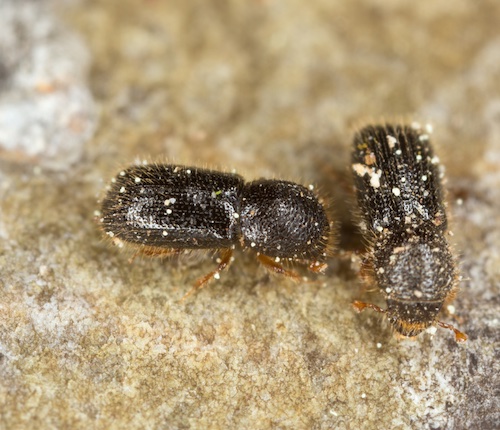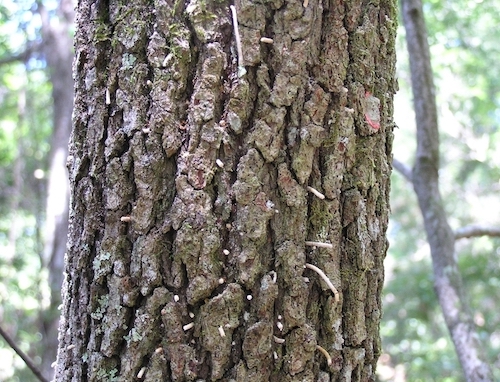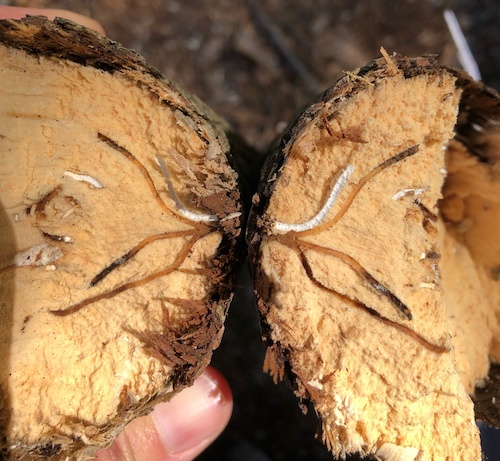Ambrosia Beetles — The Hyenas of the Insect World
by Elaine Pugh, Fairfax Master Gardener

Ambrosia beetles
Like the relationship between lions and hyenas in The Lion King, where the lions do the first line of attack and then the hyenas take out the weakened among the herd, most ambrosia beetles are natives that do not attack healthy trees. They attack woody plants (trees, shrubs and vines) that have been stressed or weakened in the plant world by repeated environmental or pathological stressors like drought or insect pests.
For the purpose of this article, I will be referring to these woody plants as trees, which are the most prominent and expensive to care for in the landscape. I also will be focusing on the native ambrosia beetles. I will be covering the non-natives in my next article.
Identification and Lifecycle
Ambrosia beetles are a group of wood-boring beetles that share an unusual behavior called “fungus farming.” These beetles carry spores of symbiotic fungi. When a woody plant has been repeatedly stressed and dying, it cries out, producing a chemical called ethanol, which in turn is a calling card that attracts native ambrosia beetles to attack. The beetles bore into the weakened tree and deposit the fungus inside long, bored holes.
I was surprised to discover that the ambrosia beetle is not one specific scientifically-named beetle. Ambrosia beetles, native and non-native, are members of two larger weevil subfamilies — Scolytinae and Platypodinae, and could be listed under Trypodendron sp., Gnathotrichus sp., Xyleborus sp. or Platypus sp. There are thousands of ambrosia beetle species found around the world and more being discovered all the time.

Ambrosia beetles noodle-like frass
Identifying the presence of the ambrosia beetle is difficult due to its teeny size. Most are less than 1/8 inch long, the size of a small ant. They are reddish brown to nearly black and cylindrical. These beetles can have one or multiple generations per year from spring through fall. They lay their eggs in the bored holes. The beetles use this fungus-filled hole to raise their young, growing through the stages of egg, larva, pupa and adult. For some species, all stages remain in the holes; other species overwinter as adults under the tree on the ground. Since the beetles do not feed directly on the tree tissue, they can circumvent the plant’s chemical defenses. And since the attack is chemically initiated, native ambrosia beetles may attack any stressed and dying woody plant, regardless of what it is.
Damage
The fungus from the beetles disrupts the flow of nutrients and water, severing the connection between the roots and the leaves, causing wilting and dieback of branches and other damage.
Signs of infestation are pin-sized-width pencils of powdery beetle frass (poop) with sawdust and some fungal mycelium extending from the trunk, powdery frass at a joint in the tree frass at the base on the ground, or the sudden death of a tree dying from the top down that has been repeatedly stressed over the years.

Ambrosia beetle galleries
Management
The main suggestion I found repeatedly to prevent ambrosia beetle damage is to keep trees well-maintained so they are not stressed and then cause attracted ambrosia beetles to attack in the first place. In some cases, if caught early, the damage can be removed by pruning. According to North Carolina Cooperative Extension, if you suspect that your trees may be infested with ambrosia beetles, it is best to consult with a certified arborist to properly diagnose the problem and quickly develop an appropriate treatment plan. However, most sources say that insecticide treatments are not practical and the dying tree, shrub or vine should be removed.
- References
- Ambrosia Beetles, Calvin Norman and Will Slater, Forest Resources, Clemson University, Factsheet HGIC 2018
- Ambrosia Beetles, Dave Coyle, Department of Forestry and Environmental Conservation, Clemson University, Clemson Cooperative Extension, Home and Garden Center
- Ambrosia Beetles – White frass on boles, U.S. Forest Service
- Ambrosia Beetles, Keith O’Herrin, North Carolina Cooperative Extension, Union County Center